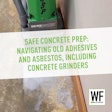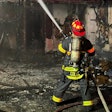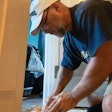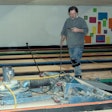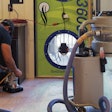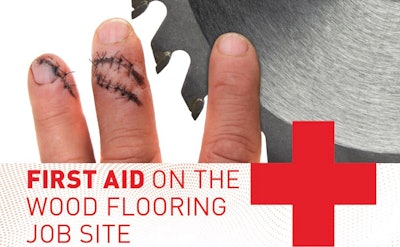
 Dr. Jonathan Ketzler
Dr. Jonathan Ketzler
Hard work, heavy objects, power tools, electrical equipment, sharp blades, splashing liquids … they're all part of being a wood flooring pro, and they can all contribute to a certain amount of danger on a wood flooring job site. Today's pros are better than ever at taking safety seriously, but accidents can and do happen. When they do, do you know what to do? Wood Floor Business talked with Dr. Jonathan Ketzler, an ICU physician and anesthesiologist at a Level 1 trauma center in Madison, Wis., to find out the facts about first aid on the wood flooring job site. Knowing the right steps to take when someone gets hurt could make the critical difference in saving a limb, saving eyesight, or even saving a life.
|
Mitchell Canter,
|
1) Lacerations
Lacerations are all too common on wood flooring job sites. Whether from a razor knife gone wrong or an ugly saw or router accident, many pros have left blood from lacerations on a job site.
The doctor says:
When it happens:
As soon as a laceration happens, elevate the wound and put pressure on it to stop the bleeding. To apply pressure, hopefully you can find something clean, but use something dirty if that's all you have available. Don't bleed to death running around looking for something sterile!
A common mistake with lacerations is to put a big cotton bandage on the wound but no pressure. The bandage gets saturated, they put another one on, and so on and so on. Meanwhile the wound is just bleeding. Pressure is the most important thing. If the wound is in a spot where you can wrap it, like around your finger, hand or wrist, you can do that to keep pressure on the wound.
Do you have to go to the ER?
If you can stop the bleeding in a reasonable amount of time—less than 30 minutes—and it isn't a severe laceration, you can probably avoid going to the ER. (FYI, you probably aren't going to hurt the wound by using the common wood flooring job site bandages of blue tape and/or duct tape.)
What is a severe laceration? One where bleeding won't stop, or where you can see exposed structures, as in ligaments, tendons, vessels, bone, muscle or fat. If you have a laceration with exposed tendons in your hand, for example, that needs to be addressed, or you could lose function in your hand. Also, if the laceration is in a place where you won't want to have big visible scar, get treatment right away. If you're losing lots of blood, have someone else drive you or just call 911. Of course, if you're getting dizzy, that's a sign that you can't drive yourself and you need treatment immediately (you're at risk of going into something called hypovolemic shock).
|
Keith McNamara, Pascoag, R.I.About a year ago I was cutting a shim with a razor blade on a set of stairs and it slipped. It cut straight up my forearm starting at my wrist. Blood squirted so far it coated the ceiling. The homeowner stopped it by ripping the belt off his wife's waist and making a tourniquet. They had to stitch the artery and obviously my arm. Everything is OK now; I just have a scar and a story. |
Steven Triplett Jr., Wood Floors West, Roseburg, Ore.I cut the tips of my fingers off on the table saw when I was 19. I don't regret it happening, though; it gave me a respect for the tools. Now, in my company, they know I'm a safety freak! We haven't had a guy get hurt on any of our jobs because I have zero patience for carelessness. They'll all thank me when they're older—right now I'm just a hardass!
|
2) Lacerations with severed body parts
Sadly, many pros know someone who has lost a finger (or more) due to a saw accident, or they themselves are missing at least part of a body part.
The doctor says:
When it happens:
Take care of the hand before you take care of the severed body part: just like any other laceration, elevate it and put pressure on the wound. If there's bleeding from a limb and it can't be controlled with pressure, use a tourniquet.
Then, if there is a salvageable limb, wrap it in cloth or a paper towel and, if possible, put that on ice. I would take any severed piece you can find into the ER, but know that if it's very small, it's unlikely they'll do anything to reattach it. DO NOT put the severed limb directly on ice, which will damage the tissue, and do not put it in water—the cells will absorb water and die. You want the severed limb to be protected and cool.

Do you have to go to the ER?
Clearly, this is a case where you need to get to the ER immediately, and the sooner you do, the better the chances of reattaching the severed limb. If you're at a smaller hospital, they will have to transfer you to a larger facility that has a microscopic vascular surgeon capable of doing the surgery. With relatively clean cuts, such as those from a chop saw or table saw, surgeries to reattach the limb can be quite successful. If it's a crush injury, they probably won't be able to.
|
Apply Enough PressureThe most common mistake with lacerations, Dr. Ketzler says, is covering the wound with a bandage but not putting enough pressure on the wound. In the photo directly above, you can see that a lot of pressure is being exerted on the wound. In the photo on the right, some loosely wrapped gauze isn't going to help stop the bleeding. |

3) Skin reactions
Some pros find they react to wood dust from certain woods, or they may have a reaction to some finishes.
The doctor says:
When it happens:
Cleanse the area with soap and water. If it's itchy and red, you can take the antihistamines diphenhydramine (brand name: Benadryl) and ranitidine (brand name: Zantac). A soothing lotion like aloe lotion can also help.
Do you have to go to the ER?
It's really unlikely that something like this will require an ER visit.

4) Electrocution
Whether it's hooking up into a panel gone wrong or walking into a wire accidentally left exposed on the job site, electricity poses a danger for wood flooring contractors. The amperage available on a typical residential job site isn't enough to kill you on the spot without extenuating circumstances, but that doesn't mean it isn't dangerous.
The doctor says:
When it happens:
After you get over the initial shock (literally), assess yourself: Do you have any persistent symptoms, such as chest pain, fatigue, or dizziness? If you have burns, they should be iced right away.
Do you have to go to the ER?
If you lost consciousness or you have any of the symptoms listed above, you need to get to the ER immediately. Having an electrical shock can disrupt the electrical conduction of the heart, putting you into dangerous and potentially fatal arrhythmias.
|
Sean Tupper, Infinity Hardwood Floors, San Diego, Calif.About 15 years ago a coworker got zapped hooking up 220 into the panel. The clip he was hooking up hit metal and the pole at the same time, and there was a huge spark toward his face, as the panel was at about face height. He literally had burn marks on his face, and his hair was standing straight up. He ended up at the ER. He didn't have any lasting effects, but that night we had a company party at Jack Murphy Stadium to watch the Padres, and he showed up with bandages all over his hands, still looking pretty confused! |

5) Eye damage
Eye protection is critical on a wood flooring job site, but there are plenty of moments when pros' eyes might be exposed and an errant splash of finish (like in the story at left) or a random wood splinter or metal piece can end up in their eyes.
The doctor says:
When it happens:
Flush out the eye immediately. If you have eye irrigation in your first aid kit, use it. If not, using clear water is absolutely fine, whether from a drinking fountain, a hose or whatever water source is closest.
Do you have to go to the ER?
After you irrigate it, if you have persistent symptoms such as eye pain or fuzzy vision, you need to go to the ER. If something small was thrown into your eye with some force, the doctor may need to use an ophthalmic burr to get down to the debris and remove it (that's not pleasant). Sometimes even after debris is out of your eye, you may have the perception that something is still in there, meaning you have a corneal scratch. In that case, you'll need to get antibiotics and possibly an eye patch.
When in doubt, go to the ER! You only have two eyes, and the consequences of ignoring a problem can be enormous: You could lose the eye, keep the eye but lose the vision, or just have a chronically painful eye.
|
Gunnar Wolfe, Wolfe's Hardwood Restoration, Sellersburg, Ind.I was cutting in some oil-based poly and the brush flicked up and threw some in my eye. I flushed my eye and used eye drops multiple times, but I was almost blind in that eye. I had to go to the doctor, and they flushed my eye over and over. It caused some almost burn-like areas on my eye. I ended up completely losing vision in my eye for almost an entire week. It was not an enjoyable process, but after almost two weeks straight of flushing my eye, we got it all fixed up. This led me to get my eyes examined, and it turns out it caused my vision to get worse. I had to update my prescription in my glasses pretty drastically. |

6) Slivers
It would probably be difficult to find people who get more slivers than wood flooring pros.
The doctor says:
When it happens:
Never try to squeeze it out, because that can cause inflammation and swelling. If you can get it out with tweezers, remove it and then wash the area with soap and water. If it's a minor sliver but you can't remove it, sometimes you need to just leave it and let it fester until it's in a place where you can get it out.
Do you have to go to the ER?
If you have a sliver that's very uncomfortable and you can't remove it, you should go have it removed. In the ER we use a large hypodermic needle to get underneath it and try to pry it out. Don't try to dig out a big sliver yourself!

7) Back pain
The opportunities to throw out your back on a wood flooring job site are numerous, but carrying something heavy like the big machine is the most common culprit.
The doctor says:
When it happens:
There isn't anything you need to do urgently when your back goes out, but of course you want to treat the pain, typically with non-steroidal anti-inflammatories and rest. The usual treatment is applying cold and progressing to heat, but I go right to heat because it feels better. For severe pain, you may need narcotics or muscle relaxants (you'll need to see a doctor for a prescription). Increasingly, we're finding that narcotics are a really bad choice for chronic pain; if your pain lasts, there are other atypical pain meds you can try (yes, marijuana is one people use that works, but there are plenty of other options).
Do you have to go to the ER?
There's no reason to go to the ER or even the doctor with back pain unless you have radiculopathy (what most people call a pinched nerve). You'll know you have it if you have pain or numbness shooting down your leg. If you do, you should go to the doctor, but there's no huge rush. In some cases, an orthopaedic surgeon will find that radiculopathy needs surgical intervention. In general, I don't think we do a very good job in Western medicine when it comes to dealing with back pain. Your best option is to prevent back pain before it happens by practicing correct body mechanics—lifting with your knees, etc.
|
Essential Item: First Aid Kits for Wood Flooring Job SitesDr. Ketzler says: I wouldn't try to piece together a first aid kit yourself; it's just too difficult. You can purchase a good professional kit for less than $100. The only thing I would add, if it doesn't already have it, is eye irrigation. |

8) Falls
Fortunately, falls aren't common, but any time someone is working on a second floor (or higher), particularly before railings are installed, they are possible (as in the story at left).
The doctor says:
When it happens:
Call 911.
If the victim isn't breathing or doesn't have a pulse, you must roll him onto his back (keeping his neck stable) and do CPR.
If the victim is breathing, awake and relatively comfortable, leave him in that position. If the victim is breathing and awake but wants to roll onto his back, stabilize his neck (just hold it aligned, not in traction, as shown in the photo above) as he is rolled onto his back. In either case, cover the victim to keep him warm in case he is going into shock.
Do you have to go to the ER?
Yes. Even if the victim doesn't seem seriously injured, a fall from a second story or higher has what we call a "fall mechanism." In other words, you could have very serious occult injuries—injuries that are not immediately obvious. For example, I know someone who fell while jumping his horse. His neck seemed sore, but otherwise he felt fine. Ten days later he found out he had broken his neck, and he had to spend six months in a halo. Had he been left undiagnosed and been injured again, his spine could have been severed. That's why we take the possibility of occult injuries very seriously.
|
Jeff Lay, Harrison Hardwoods, Richmond, Va.Nine years ago, on my first day back to work after my honeymoon, I was working on a nosing on the second floor when my extension ladder buckled. I fell and landed hard on the floor and on top of the ladder. It took me a couple minutes to catch my breath. I headed straight to a minute clinic and was x-rayed. I got really lucky with having just bad muscle spasms in my back, and they prescribed muscle relaxers. My foreman, helper and a painting crew were there when it happened. It scared the painters the most—I guess they see that often, and they expressed how lucky I was. It was my foreman Fred's old crappy ladder, so it's his fault (it still comes up now and then, LOL!). |

9) Heart Attacks
According to the Centers for Disease Control, every year about 735,000 Americans have a heart attack, and heart disease is the leading cause of death for both men and women.
The doctor says:
When it happens:
Call 911.
If you or someone you are with is having heart symptoms, don't screw around, and don't drive them to hospital—call 911! They need someone with a heart monitor and AEDs with them as soon as possible. Typical symptoms are crushing chest pain and pain that radiates to the arm or neck. You wouldn't believe how many times we get someone in the ER who had chest pain so bad they dropped to their knees … but then they felt a little better and went back to what they were doing. There are so many times we think, "If only they had called 911, this would have been so much better."
If someone collapses and isn't breathing, call 911. The 911 operator will tell you how to use an AED (if there is one available) or use CPR until help arrives.
10) Puncture wounds
Anything from a mis-fired nail gun to a homeowner's dog can cause puncture wounds on the job site.
The doctor says:
When it happens:
Puncture wounds can be deep but rarely cause much bleeding unless they are over major vascular structures. Stop the bleeding with pressure, then clean the wound with clean water, gently scrubbing to remove any debris. Then bandage the wound to keep it clean. Watch for persistent pain, swelling, pus and redness at the site. Be especially concerned if the redness is bright red and clearly demarcated or if it goes in streaks up your arm or leg.
Do you have to go to the ER?
If you have something like a nail embedded in your chest, abdomen or eye, do not remove it—go to the ER immediately.
Also, go to the ER if the wound continues to bleed after 5–10 minutes, is deep to the chest, abdomen or head, is over a joint or may be deep enough to have gotten into the joint. You also need to go to the ER if it is from a human or animal bite (if it was an animal bite, try to identify the animal so you can confirm the status of its rabies vaccination).
If you haven't had a tetanus shot in the last five years, you need a booster.
|
Sarah Fangmeyer, Petersen's Carpet & Flooring, Frederick, Md.One of our helpers, Jacob, was installing shoe molding when a finish nail ricocheted back and went through his eye (eyelid and eyeball). One of the other installers heard him exclaim "Dammit, I better not need to wear an eye patch!" Another helper drove him in the company van to the local emergency room, but that hospital was not equipped to deal with that type of injury to an eye, so he was sent by ambulance an hour away to Johns Hopkins in Baltimore for surgery. In total, he had the finish nail in his eye for eight hours before going under to have it removed. It was removed successfully and he suffered no lasting damage (he still has 20/20 vision). He was super lucky. Needless to say, all our guys are much more diligent (as they should be) about wearing eye protection since this happened. Wear your safety glasses, folks. |
RELATED: Saws 101: What You Should Have as a Wood Floor Pro

























